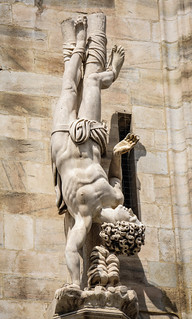Sculpture on the Duomo di Milano

The light: it was no longer just cleared space in which things took form; it had direction, it led the gaze, its shafts excavated situations isolated in the dark, sometimes it spread in a scintillating, dazzling, blazing medium without boundaries. Shadows took on substance; they stretched, flowed, condensed things in themselves. It occurred to me that I saw them that way when I was a child. Things looked different: the contours of shadows and of things that overlapped other things pushed out the contours that contained things in themselves. Flat surfaces showed corrugations, grain, stubble and texture, and sheets of gleam. And the continuity of the landscape drifting by would be abruptly broken by momentary events—the spiraling neck of a heron probing the space, the poised pause of an antelope, the legs of a child in an arabesque she will never be able to do once grown up, the grin of a passerby at something inward. The landscape is abruptly splintered, a segment isolates, magnetizes and pulls the glance into it
What a heritage Europe has! As well as the birthplace of Jozef Imrich in Bohemian Tatra Mountains and democracy in Athens, the Forum of Rome, the renaissance buildings and art of Florence, the graceful canals of Venice and the Napoleonic grandeur of Paris, there’s always the less expected sites such as the Moorish palaces of Andalucía, the remains of one of the Seven Wonders of the World in Turkey, the majesty of a second Venice in St Petersburg and the haunting buildings of Auschwitz in Poland.
Methods of collecting water for castles, abbeys, palaces and cities have led to architectural masterpieces...Sextus Julius Frontinus, the water commissioner of ancient Rome in the AD 90s, believed that the maintenance of the city’s aqueducts was the “best testimony to the greatness of the Roman Empire”. You can hardly doubt him when you visit a remaining section of ancient aqueduct such as the monumental Pont du Gard in Provence. This vertiginous structure built to supply the town of Nîmes with water is, in my view, the archaeological highlight of the south of France. It carried water from a spring some 12.5 miles away, mainly underground but at one point spectacularly on a three-tier aqueduct 164ft above the river Gard below...
It was perhaps the religious and symbolic role of water in cleansing the body and soul in both Muslim and Christian traditions that made it so integral to European medieval monasteries. It has always surprised me how sophisticated the water supply systems of abbeys were in comparison with the average medieval castle. Running water for hand-washing and flushing latrines was commonplace if you were a monk, but a wealthy knight would often have only a well in his castle and an outshoot for his latrine that dumped his excrement into the moat. Where there is a Well ... There is a history (Well, there is a brilliant description of a well inside that Cold River
Milan is famous as one of the world’s most dynamic fashion and design capitals but there’s one monument whose design will never run out of fashion: the Duomo. The Duomo is the largest cathedral in Italy and one of the largest in the world...
Milan has been one of Italy’s most prosperous cities since the Middle Ages. Although it is best known for its fashion credentials, it is in the field of industrial design that it really excels. true colours of our Mila, means dear sweetheart in Slavic tongues